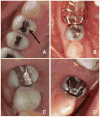Treatment recommendations for single-unit crowns: Findings from The National Dental Practice-Based Research Network
- PMID: 27492046
- PMCID: PMC5086281
- DOI: 10.1016/j.adaj.2016.06.012
Treatment recommendations for single-unit crowns: Findings from The National Dental Practice-Based Research Network
Abstract
Background: The objectives of this study were to quantify practitioner variation in likelihood to recommend a crown and test whether certain dentist, practice, and clinical factors are associated significantly with this likelihood.
Methods: Dentists in The National Dental Practice-Based Research Network completed a questionnaire about indications for single-unit crowns. In 4 clinical scenarios, practitioners ranked their likelihood of recommending a single-unit crown. The authors used these responses to calculate a dentist-specific crown factor (range, 0-12). A higher score implied a higher likelihood of recommending a crown. The authors tested certain characteristics for statistically significant associations with the crown factor.
Results: A total of 1,777 of 2,132 eligible dentists (83%) responded. Practitioners were most likely to recommend crowns for teeth that were fractured, cracked, or endodontically treated or had a broken restoration. Practitioners overwhelmingly recommended crowns for posterior teeth treated endodontically (94%). Practice owners, practitioners in the Southwest, and practitioners with a balanced workload were more likely to recommend crowns, as were practitioners who used optical scanners for digital impressions.
Conclusions: There is substantial variation in the likelihood of recommending a crown. Although consensus exists in some areas (posterior endodontic treatment), variation dominates in others (size of an existing restoration). Recommendations varied according to type of practice, network region, practice busyness, patient insurance status, and use of optical scanners.
Practical implications: Recommendations for crowns may be influenced by factors unrelated to tooth and patient variables. A concern for tooth fracture-whether from endodontic treatment, fractured teeth, or large restorations-prompted many clinicians to recommend crowns.
Keywords: Dentistry; crowns; prosthodontics.
Copyright © 2016 American Dental Association. Published by Elsevier Inc. All rights reserved.
Similar articles
-
Remake Rates for Single-Unit Crowns in Clinical Practice: Findings from The National Dental Practice-Based Research Network.J Prosthodont. 2019 Feb;28(2):122-130. doi: 10.1111/jopr.12995. Epub 2018 Nov 22. J Prosthodont. 2019. PMID: 30412320 Free PMC article.
-
Impression evaluation and laboratory use for single-unit crowns: Findings from The National Dental Practice-Based Research Network.J Am Dent Assoc. 2017 Nov;148(11):788-796.e4. doi: 10.1016/j.adaj.2017.06.015. Epub 2017 Aug 16. J Am Dent Assoc. 2017. PMID: 28822536 Free PMC article.
-
Impression Techniques Used for Single-Unit Crowns: Findings from the National Dental Practice-Based Research Network.J Prosthodont. 2018 Oct;27(8):722-732. doi: 10.1111/jopr.12577. Epub 2017 Jan 11. J Prosthodont. 2018. PMID: 28076661 Free PMC article.
-
Agreement among dentists' restorative treatment planning thresholds for primary occlusal caries, primary proximal caries, and existing restorations: findings from The National Dental Practice-Based Research Network.J Dent. 2013 Aug;41(8):718-25. doi: 10.1016/j.jdent.2013.05.014. Epub 2013 Jun 3. J Dent. 2013. PMID: 23743181 Free PMC article.
-
Lessons learned from the Cracked Tooth Registry: A 3-year clinical study in the Nation's Network.J Am Dent Assoc. 2023 Mar;154(3):235-244. doi: 10.1016/j.adaj.2022.11.020. Epub 2023 Jan 21. J Am Dent Assoc. 2023. PMID: 36690539 Free PMC article. Review.
Cited by
-
Retention of CAD/CAM resin composite crowns following different bonding protocols.Am J Dent. 2018 Apr;31(2):97-102. Am J Dent. 2018. PMID: 29630794 Free PMC article.
-
Factors Influencing the Selection of Materials and Luting Agents for Single-Crown Restorations.Dent J (Basel). 2025 May 9;13(5):207. doi: 10.3390/dj13050207. Dent J (Basel). 2025. PMID: 40422627 Free PMC article.
-
Participation Rates in 11 National Dental Practice-Based Research Network Surveys 2014-2022.Eval Health Prof. 2025 Jun;48(2):242-255. doi: 10.1177/01632787241259186. Epub 2024 Jun 6. Eval Health Prof. 2025. PMID: 38843535
-
Remake Rates for Single-Unit Crowns in Clinical Practice: Findings from The National Dental Practice-Based Research Network.J Prosthodont. 2019 Feb;28(2):122-130. doi: 10.1111/jopr.12995. Epub 2018 Nov 22. J Prosthodont. 2019. PMID: 30412320 Free PMC article.
-
Laboratory Technician Assessment of the Quality of Single-Unit Crown Preparations and Impressions as Predictors of the Clinical Acceptability of Crowns as Determined by the Treating Dentist: Findings from the National Dental Practice-Based Research Network.J Prosthodont. 2020 Feb;29(2):114-123. doi: 10.1111/jopr.13137. Epub 2020 Jan 11. J Prosthodont. 2020. PMID: 31893566 Free PMC article.
References
-
- Bader JD, Shugars DA. Summary review of the survival of single crowns. Gen Dent. 2009;57(1):74–81. - PubMed
-
- Bader JD, Shugars DA, Roberson TM. Using crowns to prevent tooth fracture. Community Dent Oral Epidemiol. 1996;24(1):47–51. - PubMed
-
- Bader JD, Shugars DA, Martin JA. Risk indicators for posterior tooth fracture. J Am Dent Assoc. 2004;135(7):883–92. - PubMed
-
- Fernandez E, Martin J, Vildosola P, et al. Can repair increase the longevity of composite resins? Results of a 10-year clinical trial. J Dent. 2015;43(2):279–86. - PubMed
Publication types
MeSH terms
Grants and funding
LinkOut - more resources
Full Text Sources
Other Literature Sources


